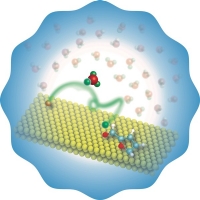“A group of chemical engineering graduate and undergraduate students participated in the discovery of water as a participant in the catalytic conversion of furfural without inhibiting the reaction and leading to a great rate enhancement in the process,” said Bin Wang, assistant professor in the School of Chemical, Biological and Materials Engineering, Gallogly College of Engineering.
Furfural is a biomass-derived compound that is considered a valuable platform for production of fuels and chemicals. An important strategy is to hydrogenate the molecule so it can be used in the chemical industry later. The group has shown that when the molecule contains an oxygenated group, hydrogenation occurs from the liquid phase instead of the catalyst surface.
In the absence of water, all steps in the reaction occur on the catalyst surface. In the presence of water as a solvent, the hydrogen can be ‘shuttled’ through the water molecule in a higher rate for the reaction. This latter path requires a lower energy barrier to take place and is faster. An article describing this unique mechanism has been published in Nature Catalysis.
The OU Catalysis Group received a U.S. Department of Energy grant in the amount of $650,000 to further explore the role of water in upgrading renewable fuels in the chemical production of energy.
For more information, contact OU Professor Resasco at resasco@ou.edu or OU Professor Wang at wang_cbme@ou.edu.

